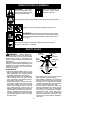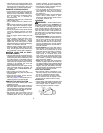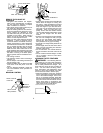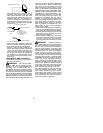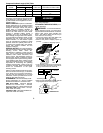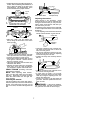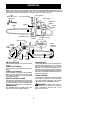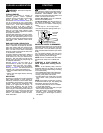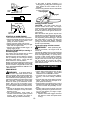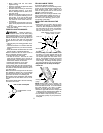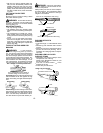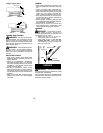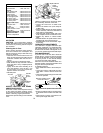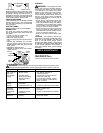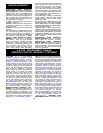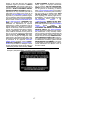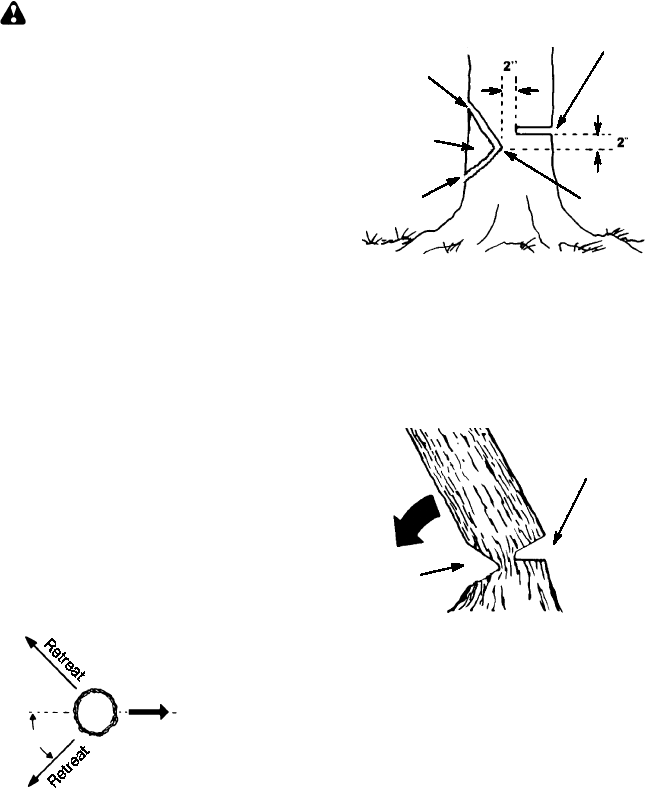
11
S
Begin cutting with the saw frame
against the log.
S
Keep the engine at full speed the entire
time you are cutting.
S
Allow thechain tocutforyou. Exert only
light downward pressure. If you force
the cut, damage t othe bar ,chain, oren-
gine can result.
S
Release the throttle trigger as soon as
the cut is completed, allowing the en-
gine to idle. If you run the saw at full
throttle w ithout a cutting load, unneces-
sary wear can occur to the chain, bar,
and engine.
S
Toavoid losing control whencut iscom-
plete, donot putpressure onsawat end
of cut.
S
Stop t he engine before setting the saw
down after cutting.
TREE FELLING TECHNIQUES
WARNING:
Check for br oken or
dead branches which can fall while cutting
causing serious injury. D o not cut near build-
ings or electrical wires if you do not know the
direction of tree fall, nor cut a t night since you
will not be ale to see well, nor during bad
weather such as r ain, s now, o r strong winds,
etc.
S
Carefully plan yoursawing operation inad-
vance.
S
Cleartheworkarea. Youneed aclear area
all around the tree so you can have secure
footing.
S
Study the natural conditions that can cause
the tree to fall in a particular dir ection.
Natural conditions that can cause a tree to
fall i n a particular direction include:
S
The wind direction and speed.
S
The lean of the tree. The lean of a tree
might not be apparent due to uneven or
sloping terrain. Useaplumb orlevel to de-
termine the direction of tree lean.
S
Weight and branches on one s ide.
S
Surrounding trees and obstacles.
Look for decay and rot. If the trunk is rotted, i t
can snap and fall toward the operator. Check
for broken o r dead branches which can fall on
you w hile cutting.
Make sure there is enough r oom for the treeto
fall. Maintain a distance of
2-1/2
tree lengths
from the nearest person or other objects. En-
gine noise can d row n out a warning call.
Removedirt, stones, loose bark, nails, staples,
and wire fr om the tree w her e cuts ar e to be
made.
Plan a clear retreat path to the rear and diag-
onal to the line of fall.
Direction of Fall
45
_
Plan a clear retreat path
FELLING LARGE TREES
(6 inches in diameter or l arger)
The notch method is used to fell large trees.
Anotch is cut onthe side ofthe treein thede-
sired direction of fall. After a felling cut is
made on the opposite side of tree, the tree
will tend to fall into the notch.
NOTE:
If the tree has large buttress roots,
remove them bef ore making the notch. If
using saw to remove buttress roots, keep
saw chain from contacting ground to pre-
vent dulling of the chain.
NOTCH CUT AND FELLING THE
TREE
S
Make notch cut by cutting the top of the
notch first. Cut through
1/3
of the diameter
ofthe tree. Nextcomplete thenotch bycut-
ting the bottom of the notch. See illustra-
tion. Once the notch is cut remove the
notch of wood from the tree.
Notch
First cut
Second cut
Final (felling) cut here. 2 inches
above center of notch.
Hinge
S
After removing the cutout of wood, make
the felling cut on the opposite side of the
notch. This is done by making a cut about
two inches higher than the center of the
notch. This will l eave enough uncut wood
between the felling cut and the notch to
form a hinge. This hinge will help prevent
the tree f rom falling in the wrong direction.
Opening
of felling
cut
Closing of
notch
Hinge holds tree on stump and helps
control fall
NOTE:
Before felling cut is complete, use
wedges to open the cut when necessary to
control the direction of fall. Toavoid kickback
and chain damage, use wood or plastic
wedges, but never steel or iron wedges.
S
Be al ert to signs that the tree isready to fall:
crack ing s ounds, w idening of the felling cut,
or m ovement in t he upper branches.
S
As tree s tarts to fall, stop saw, put it down,
and get away quickly on your planned re-
treat pat h.



